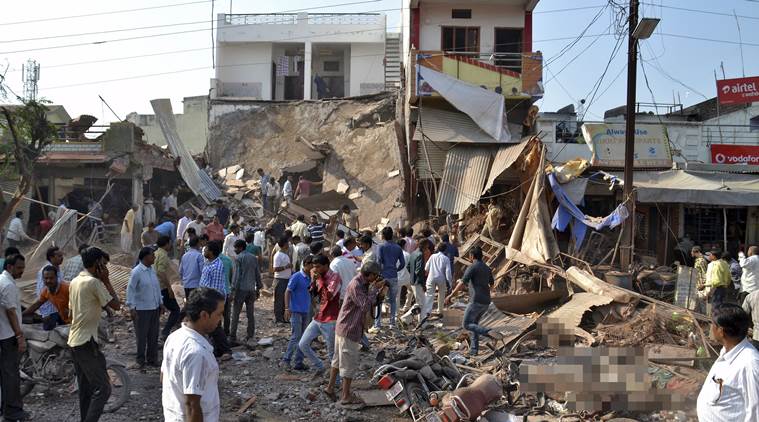
Until 11.30 pm, five hours after seven bombs rocked Mumbai local trains, the civic-run Sion hospital, which was nearest to the spot had 43 dead bodies, more than double its morgue capacity. Like the 1993 blasts, over 100 deaths were reported in less than an hour in city hospitals.
The bodies were badly mutilated. Sion hospital morgue had a capacity of 22 bodies (now upgraded to 78).
It took hours to vacate an OPD ward to place the increasing number of mutilated bodies. “We realized then, that resource management needs to be improved,” assistant professor at forensic department Dr Rajesh Dere said.
There were talks of a system to grade the injured to ensure treatment is first given to the severely injured during disasters, but it has not been implemented.
While National Disaster Management Authority (NDMA) recommends identification of warehouses for storing bodies in case of mass casualties, doctors at tertiary-care hospitals admit no such back-up options are present, either under the state government or the civic body guidelines.
The 2006 blasts had something forensic experts were not used to, bodies mutilated beyond recognition. In the days that followed the blasts, relatives had to run from one hospital to another looking for bodies.
The difficult part was showing mutilated limbs or body parts for identification, forensic experts admit. “The disaster made us realize that a centralized system needs to be generated where, whenever there is a disaster, pictures could be clicked of dead bodies and their belongings and numbered. Relatives could view the picture for identification.
This would save them the trouble of running around,” Dr Harish Pathak, KEM Hospital’s forensic department head said. No such system is in place. In case a disaster strikes, each civic and state hospital documents dead bodies without co-coordinating with the other hospitals. The disaster plan sets guidelines for a nodal officer in each public hospital to be the point of contact.
For the 24 civic hospitals, just one nodal officer has been assigned, apart from another nodal officer at JJ hospital. Additionally, the triage system continues to remain in books. According to Dere, in case of mass casualties, social workers and police officers first identify critical patients and send them to the nearest hospital. “Currently, it is like first come, first admit.
In such cases, those in need of urgent medical attention may be left behind. By the time they are transported to a hospital, they lose the golden hour period,” Dere said. According to experts, in a triage, patients requiring immediate attention are marked ‘red’ while those with less serious injuries are marked ‘yellow’. The dead are marked ‘black’ and can be attended to last.
“Police need to be sensitized on the triage method. This will help in saving lives,” Pathak said
Last to be disposed — skull of ‘bomber’
A part of the skull bone, half frontal face with a cracked maxilla and broken cheekbones were the last remains of a body disposed off after the 7/11 Mumbai train blasts. The skull, buried 186 days after the blasts, was suspected to be of a terrorist named Salim, though it could never be confirmed. He was the 187th person to be buried in the weeks that followed the blasts.
In the years that followed, two other victims— Ashfaq Khan and Parag Sawant— passed away bringing the death toll to 189.
Forensic experts, part of the investigation in 2006, remember how the half charred face was brought to them within hours of the blasts on July 11, 2006. In the next three days, 186 of the 187 bodies, rather parts of bodies, were identified and claimed by relatives. Except that one skull.
“We then suspected that the skull may belong to the bomber himself,” said Dr Harish Pathak, then associate professor at forensic department of civic-run Sion hospital, where the skull was kept in the morgue. The hospital contacted ATS who arranged for facial reconstruction for identification.
A team of plastic surgeons, dental surgeons and forensic experts reconstructed the face, said Dr Rajesh Dere, currently assistant professor in Sion hospital’s forensic department. The half skull bone had broken into over a dozen pieces which had to be carefully put together, he said.
“The maxilla (part of upper jaw and palate) had cracked and we required a dental team to fix it. In the process of reconstruction, we realized that the deceased must have been very close to the bomb when it went off,” Pathak said. The forensic experts believe that the bomb was either in the backpack or close to the mid-riff of the “bomber” and the explosion blew almost the whole of his body.
The team took a week to reconstruct the facial bone following which plastic surgeons helped in creating a cosmetic skin. The probable face structure was generated on computer and an artist was called to make a sketch. “The sketch was circulated among investigating agencies, but nothing came out of it,” a doctor, who was part of the team, said.
Saturday 12 September 2015
http://indianexpress.com/article/cities/mumbai/711-verdict-lessons-learnt-from-2006-blasts/
http://indianexpress.com/article/cities/mumbai/711-verdict-last-to-be-disposed-skull-of-bomber/



